ACURA TL 1995 Service Repair Manual
Manufacturer: ACURA, Model Year: 1995, Model line: TL, Model: ACURA TL 1995Pages: 1771, PDF Size: 62.49 MB
Page 1531 of 1771
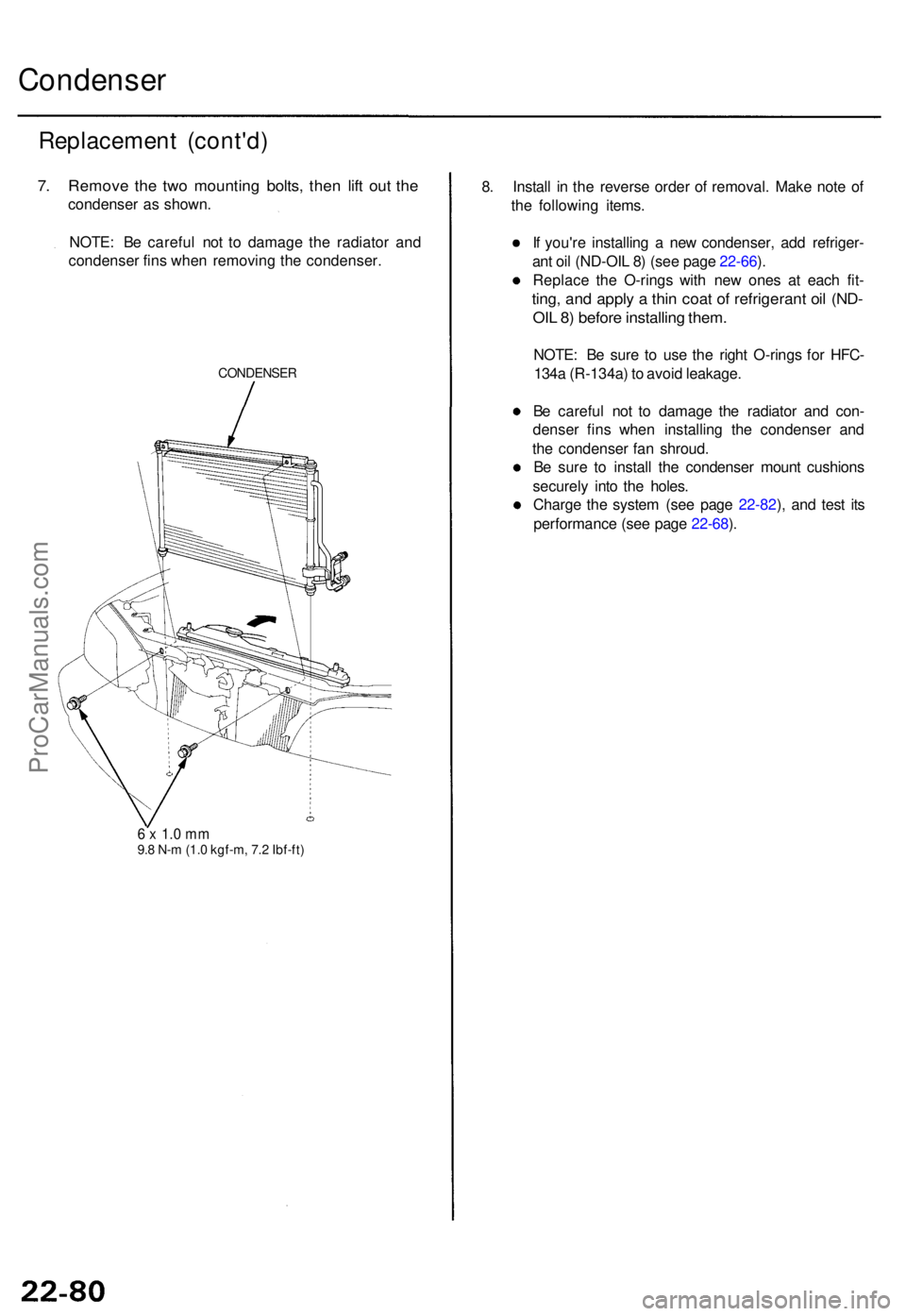
Condenser
Replacemen t (cont'd )
7. Remov e th e tw o mountin g bolts , the n lif t ou t th e
condense r a s shown .
NOTE : B e carefu l no t t o damag e th e radiato r an d
condense r fin s whe n removin g th e condenser .
CONDENSE R
6 x 1. 0 m m9.8 N- m (1. 0 kgf-m , 7. 2 Ibf-ft )
8. Instal l i n th e revers e orde r o f removal . Mak e not e o f
th e followin g items .
I f you'r e installin g a ne w condenser , ad d refriger -
an t oi l (ND-OI L 8 ) (se e pag e 22-66 ).
Replac e th e O-ring s wit h ne w one s a t eac h fit -
ting , an d appl y a thi n coa t o f refrigeran t oi l (ND -
OI L 8 ) befor e installin g them .
NOTE : B e sur e t o us e th e righ t O-ring s fo r HFC -
134 a (R-134a ) t o avoi d leakage .
B e carefu l no t t o damag e th e radiato r an d con -
dense r fin s whe n installin g th e condense r an d
th e condense r fa n shroud .
B e sur e t o instal l th e condense r moun t cushion s
securel y int o th e holes .
Charg e th e syste m (se e pag e 22-82 ), an d tes t it s
performanc e (se e pag e 22-68 ).
ProCarManuals.com
Page 1532 of 1771
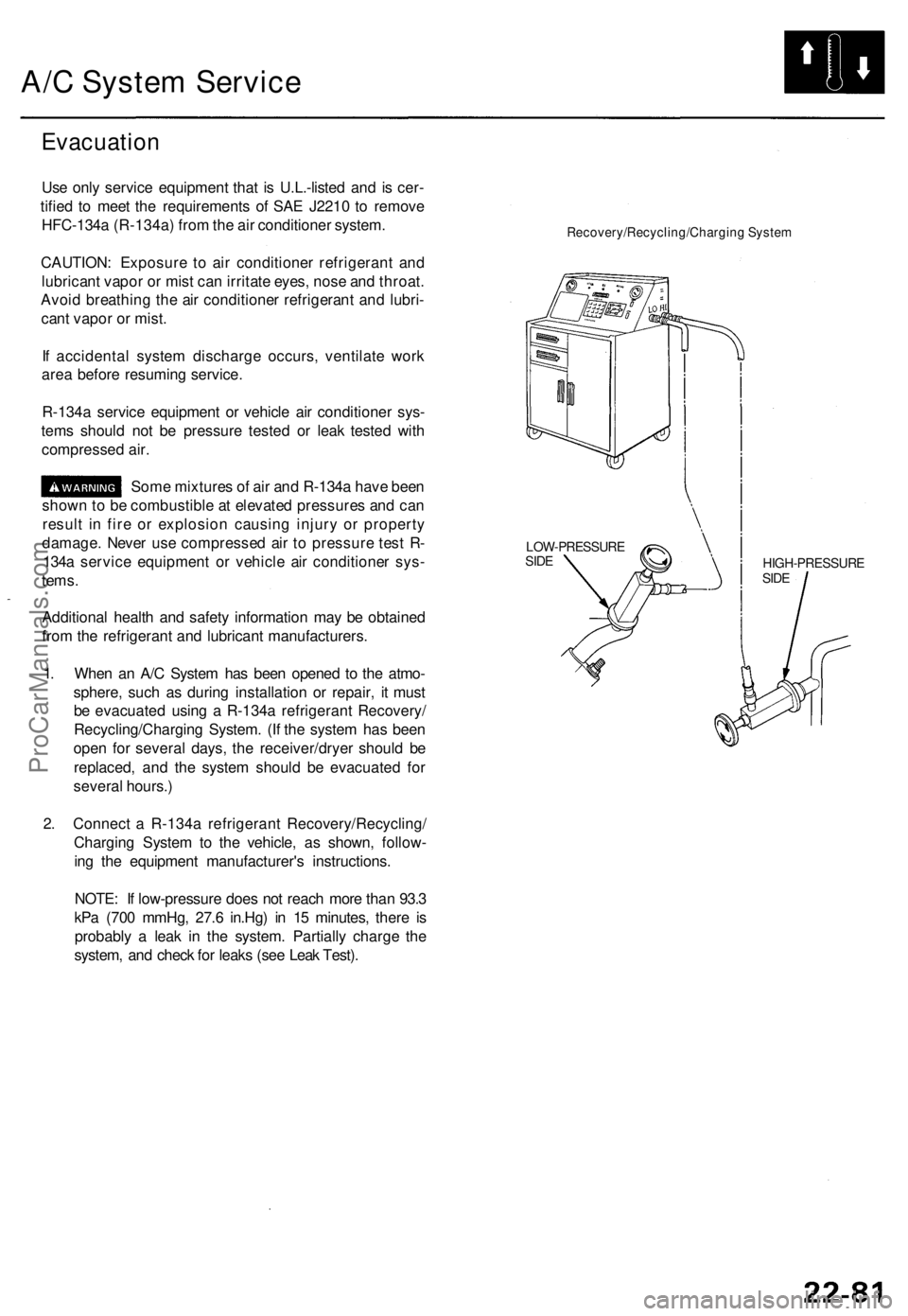
A/C System Service
Evacuation
Use only service equipment that is U.L.-listed and is cer-
tified to meet the requirements of SAE J2210 to remove
HFC-134a (R-134a) from the air conditioner system.
CAUTION: Exposure to air conditioner refrigerant and
lubricant vapor or mist can irritate eyes, nose and throat.
Avoid breathing the air conditioner refrigerant and lubri-
cant vapor or mist.
If accidental system discharge occurs, ventilate work
area before resuming service.
R-134a service equipment or vehicle air conditioner sys-
tems should not be pressure tested or leak tested with
compressed air.
Some mixtures of air and R-134a have been
shown to be combustible at elevated pressures and can
result in fire or explosion causing injury or property
damage. Never use compressed air to pressure test R-
134a service equipment or vehicle air conditioner sys-
tems.
Additional health and safety information may be obtained
from the refrigerant and lubricant manufacturers.
1. When an A/C System has been opened to the atmo-
sphere, such as during installation or repair, it must
be evacuated using a R-134a refrigerant Recovery/
Recycling/Charging System. (If the system has been
open for several days, the receiver/dryer should be
replaced, and the system should be evacuated for
several hours.)
2. Connect a R-134a refrigerant Recovery/Recycling/
Charging System to the vehicle, as shown, follow-
ing the equipment manufacturer's instructions.
NOTE: If low-pressure does not reach more than 93.3
kPa (700 mmHg, 27.6 in.Hg) in 15 minutes, there is
probably a leak in the system. Partially charge the
system, and check for leaks (see Leak Test).
Recovery/Recycling/Charging System
HIGH-PRESSURE
SIDE
LOW-PRESSURE
SIDEProCarManuals.com
Page 1533 of 1771
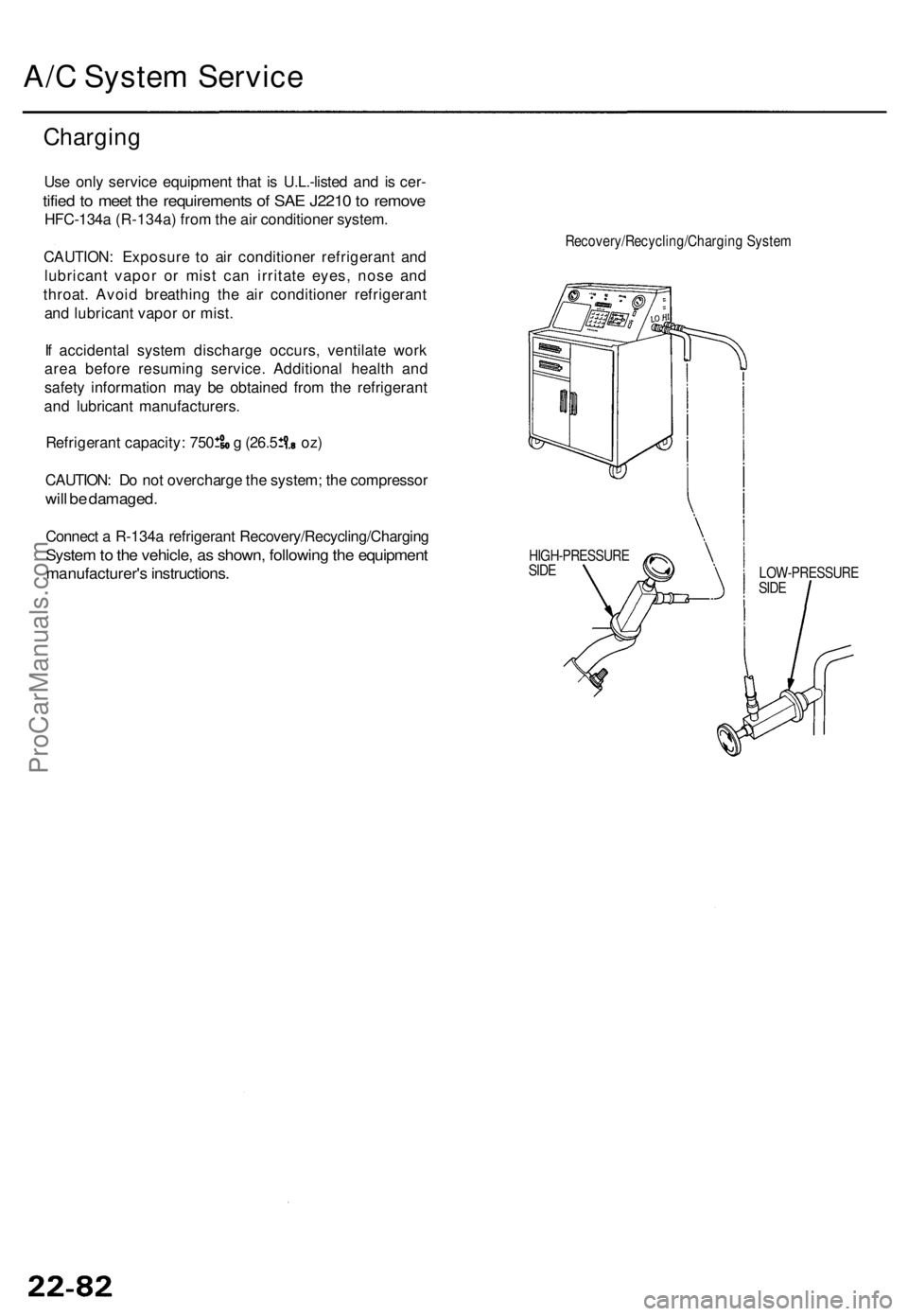
A/C Syste m Servic e
Chargin g
Use onl y servic e equipmen t tha t i s U.L.-liste d an d i s cer -
tified to mee t th e requirement s o f SA E J221 0 to remov e
HFC-134 a (R-134a ) fro m th e ai r conditione r system .
CAUTION : Exposur e t o ai r conditione r refrigeran t an d
lubricant vapor o r mis t ca n irritat e eyes , nos e an d
throat . Avoi d breathin g th e ai r conditione r refrigeran t
an d lubrican t vapo r o r mist .
I f accidenta l syste m discharg e occurs , ventilat e wor k
are a befor e resumin g service . Additiona l healt h an d
safet y informatio n ma y b e obtaine d fro m th e refrigeran t
an d lubrican t manufacturers .
Refrigerant capacity : 75 0 g (26.5 oz )
CAUTION : D o no t overcharg e th e system ; th e compresso r
will b e damaged .
Connect a R-134 a refrigeran t Recovery/Recycling/Chargin g
System to th e vehicle , a s shown , followin g th e equipmen t
manufacturer' s instructions .
Recovery/Recycling/Chargin g Syste m
LOW-PRESSUR ESIDE
HIGH-PRESSUR ESIDE
ProCarManuals.com
Page 1534 of 1771
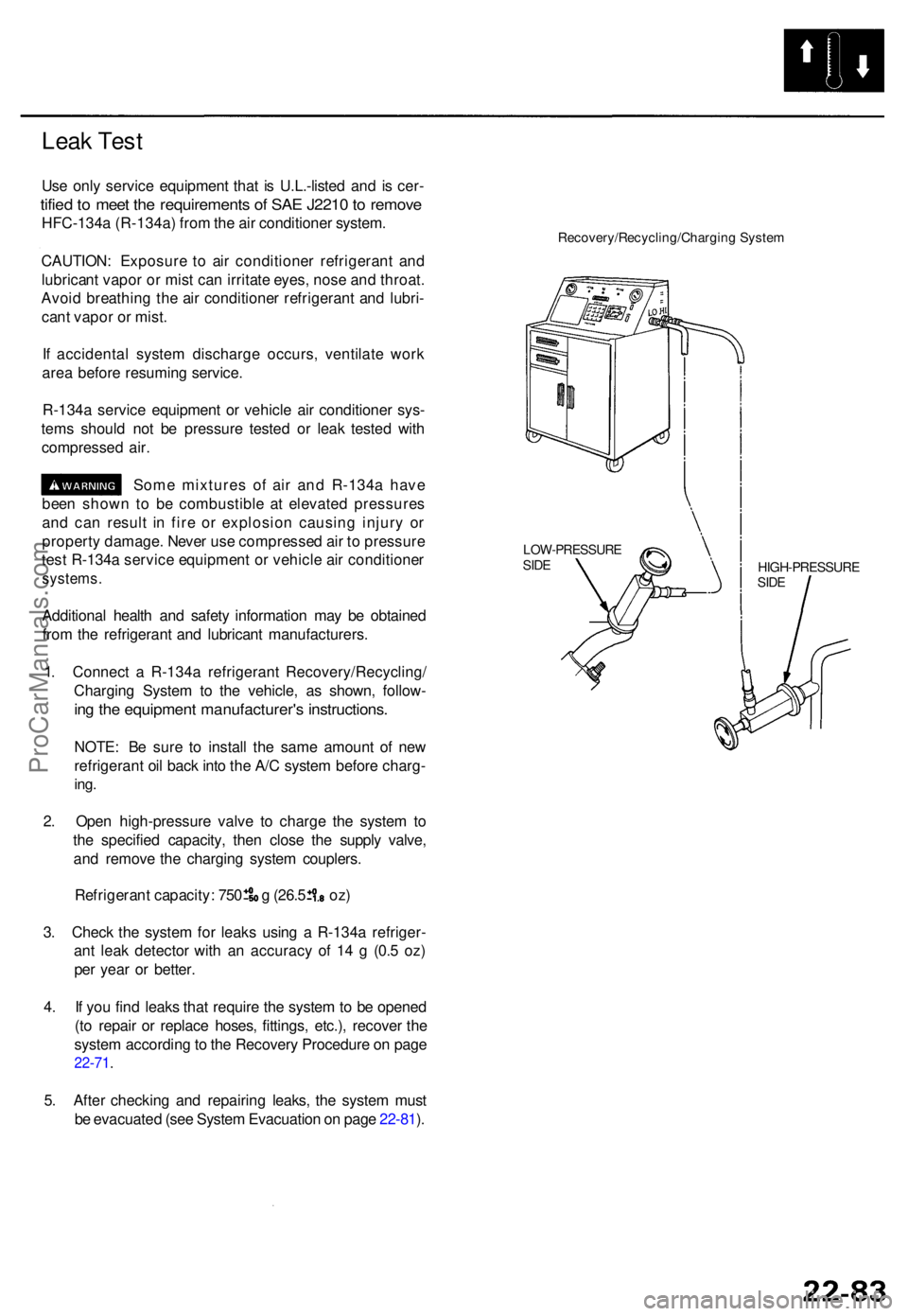
Leak Tes t
Use onl y servic e equipmen t tha t i s U.L.-liste d an d i s cer -
tified to mee t th e requirement s o f SA E J221 0 to remov e
HFC-134 a (R-134a ) fro m th e ai r conditione r system .
CAUTION : Exposur e t o ai r conditione r refrigeran t an d
lubrican t vapo r o r mis t ca n irritat e eyes , nos e an d throat .
Avoi d breathin g th e ai r conditione r refrigeran t an d lubri -
can t vapo r o r mist .
I f accidenta l syste m discharg e occurs , ventilat e wor k
are a befor e resumin g service .
R-134 a servic e equipmen t o r vehicl e ai r conditione r sys -
tem s shoul d no t b e pressur e teste d o r lea k teste d wit h
compresse d air .
Som e mixture s o f ai r an d R-134 a hav e
bee n show n t o b e combustibl e a t elevate d pressure s
an d ca n resul t i n fir e o r explosio n causin g injur y o r
propert y damage . Neve r us e compresse d ai r t o pressur e
tes t R-134 a servic e equipmen t o r vehicl e ai r conditione r
systems.
Additiona l healt h an d safet y informatio n ma y b e obtaine d
fro m th e refrigeran t an d lubrican t manufacturers .
1 . Connec t a R-134 a refrigeran t Recovery/Recycling /
Chargin g Syste m to th e vehicle , a s shown , follow -
ing th e equipmen t manufacturer' s instructions .
NOTE: B e sur e t o instal l th e sam e amoun t o f ne w
refrigeran t oi l bac k int o th e A/ C syste m befor e charg -
ing.
2. Ope n high-pressur e valv e t o charg e th e syste m to
th e specifie d capacity , the n clos e th e suppl y valve ,
an d remov e th e chargin g syste m couplers .
Refrigeran t capacity : 75 0 g (26.5 oz )
3 . Chec k th e syste m fo r leak s usin g a R-134 a refriger -
an t lea k detecto r wit h a n accurac y o f 1 4 g (0. 5 oz )
pe r yea r o r better .
4 . I f yo u fin d leak s tha t requir e th e syste m to b e opene d
(t o repai r o r replac e hoses , fittings , etc.) , recove r th e
syste m accordin g to th e Recover y Procedur e o n pag e
22-71 .
Recovery/Recycling/Chargin g Syste m
HIGH-PRESSUR ESIDE
5. Afte r checkin g an d repairin g leaks , th e syste m mus t
b e evacuate d (se e Syste m Evacuatio n o n pag e 22-81 ).
LOW-PRESSUR ESIDE
ProCarManuals.com
Page 1535 of 1771
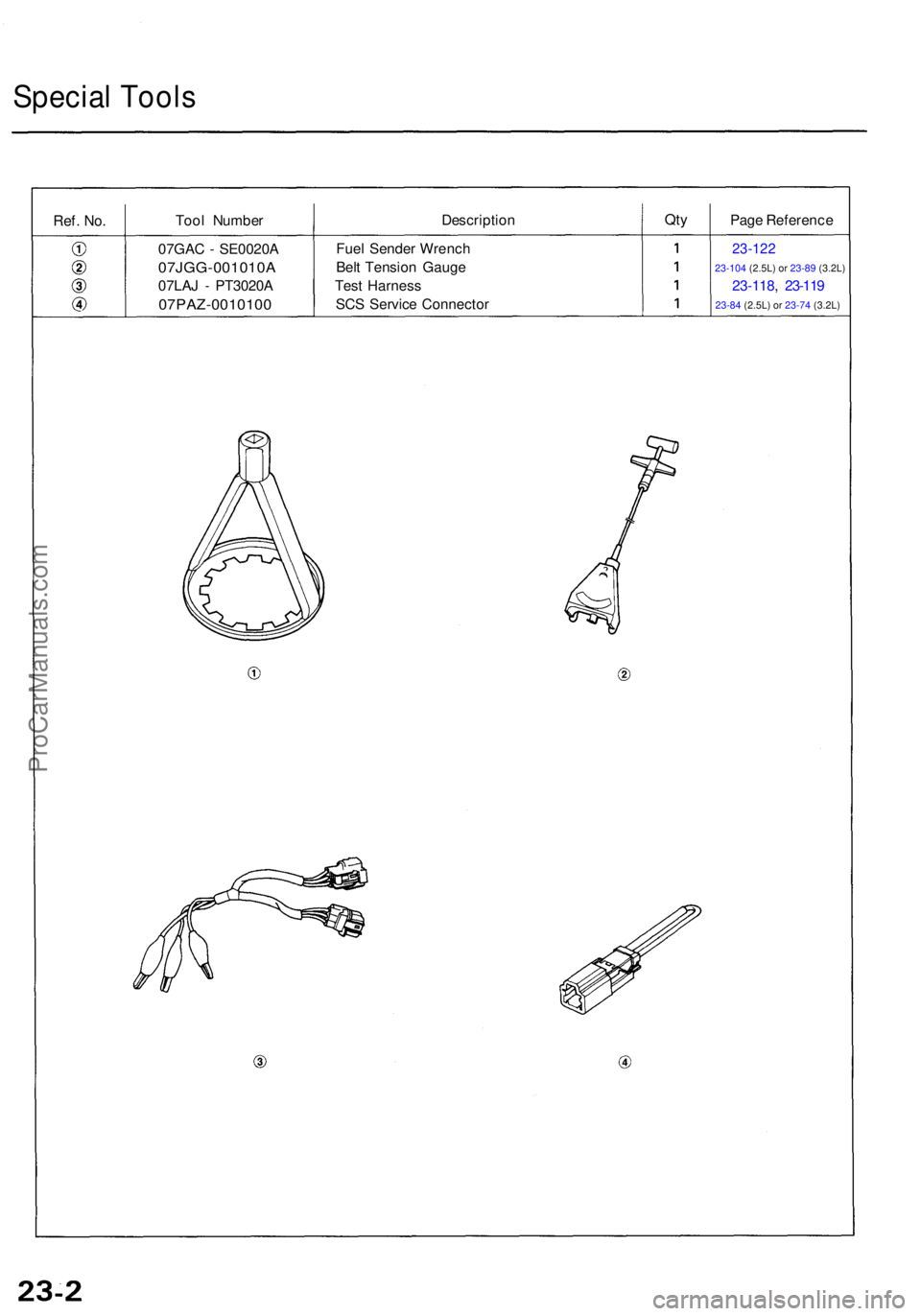
Special Tool s
Ref. No.Too l Numbe r Descriptio
nQtyPag e Referenc e
07GA C - SE0020 A
07JGG-001010 A
07LAJ - PT3020 A
07PAZ-001010 0
Fuel Sende r Wrenc h
Bel t Tensio n Gaug e
Tes t Harnes s
SC S Servic e Connecto r23-122
23-104 (2.5L) or 23-89 (3.2L)
23-118 , 23-11 9
23-84 (2.5L) or 23-74 (3.2L)
ProCarManuals.com
Page 1536 of 1771
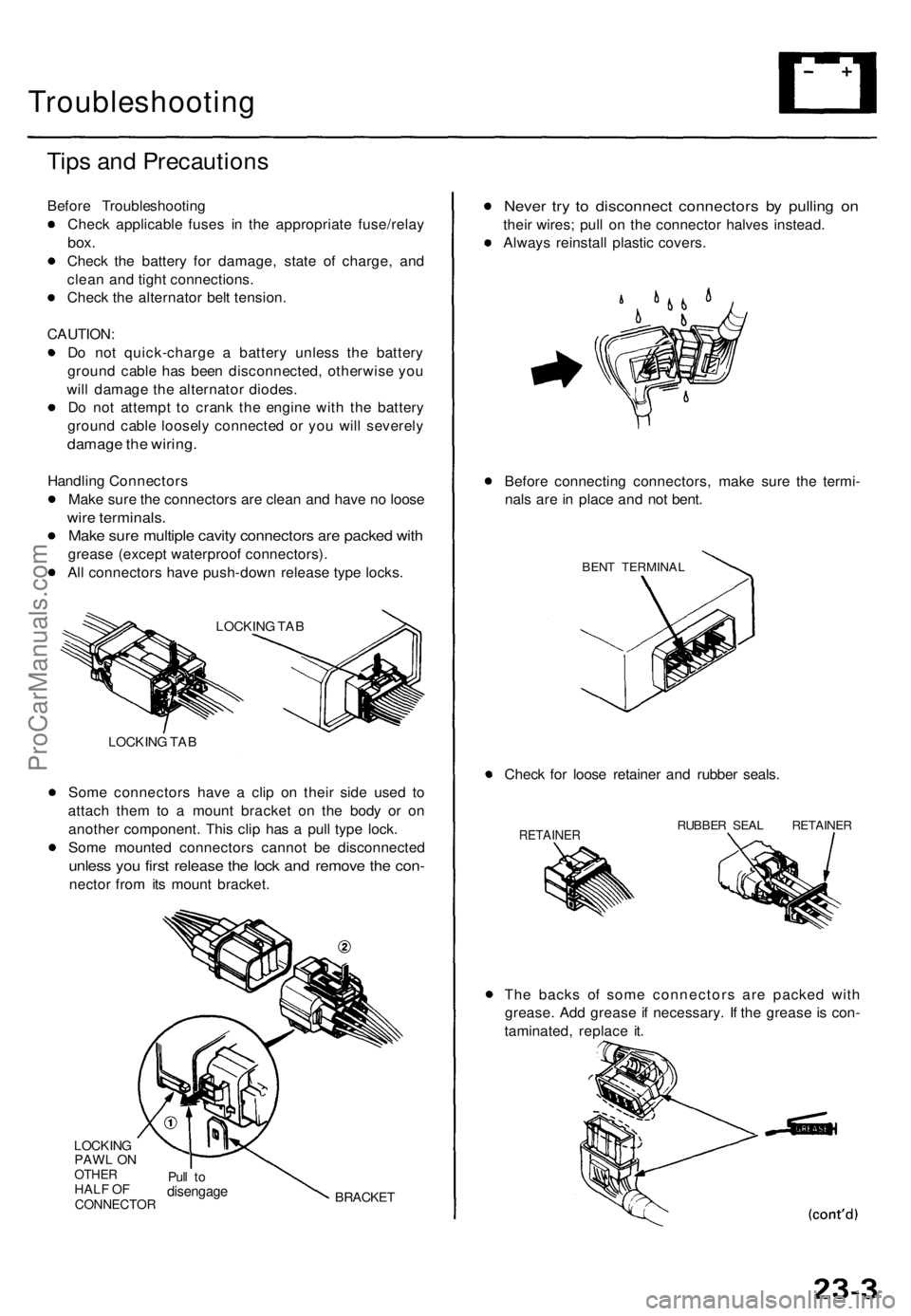
Troubleshooting
Tips and Precautions
Before Troubleshooting
Check applicable fuses in the appropriate fuse/relay
box.
Check the battery for damage, state of charge, and
clean and tight connections.
Check the alternator belt tension.
CAUTION:
Do not quick-charge a battery unless the battery
ground cable has been disconnected, otherwise you
will damage the alternator diodes.
Do not attempt to crank the engine with the battery
ground cable loosely connected or you will severely
damage the wiring.
Handling Connectors
Make sure the connectors are clean and have no loose
wire terminals.
Make sure multiple cavity connectors are packed with
grease (except waterproof connectors).
All connectors have push-down release type locks.
LOCKING TAB
Some connectors have a clip on their side used to
attach them to a mount bracket on the body or on
another component. This clip has a pull type lock.
Some mounted connectors cannot be disconnected
unless you first release the lock and remove the con-
nector from its mount bracket.
LOCKING
PAWL ON
OTHER
HALF OF
CONNECTOR
Pull to
disengage
BRACKET
Never try to disconnect connectors by pulling on
their wires; pull on the connector halves instead.
Always reinstall plastic covers.
Before connecting connectors, make sure the termi-
nals are in place and not bent.
BENT TERMINAL
Check for loose retainer and rubber seals.
RETAINER
RUBBER SEAL RETAINER
The backs of some connectors are packed with
grease. Add grease if necessary. If the grease is con-
taminated, replace it.
LOCKING TABProCarManuals.com
Page 1537 of 1771
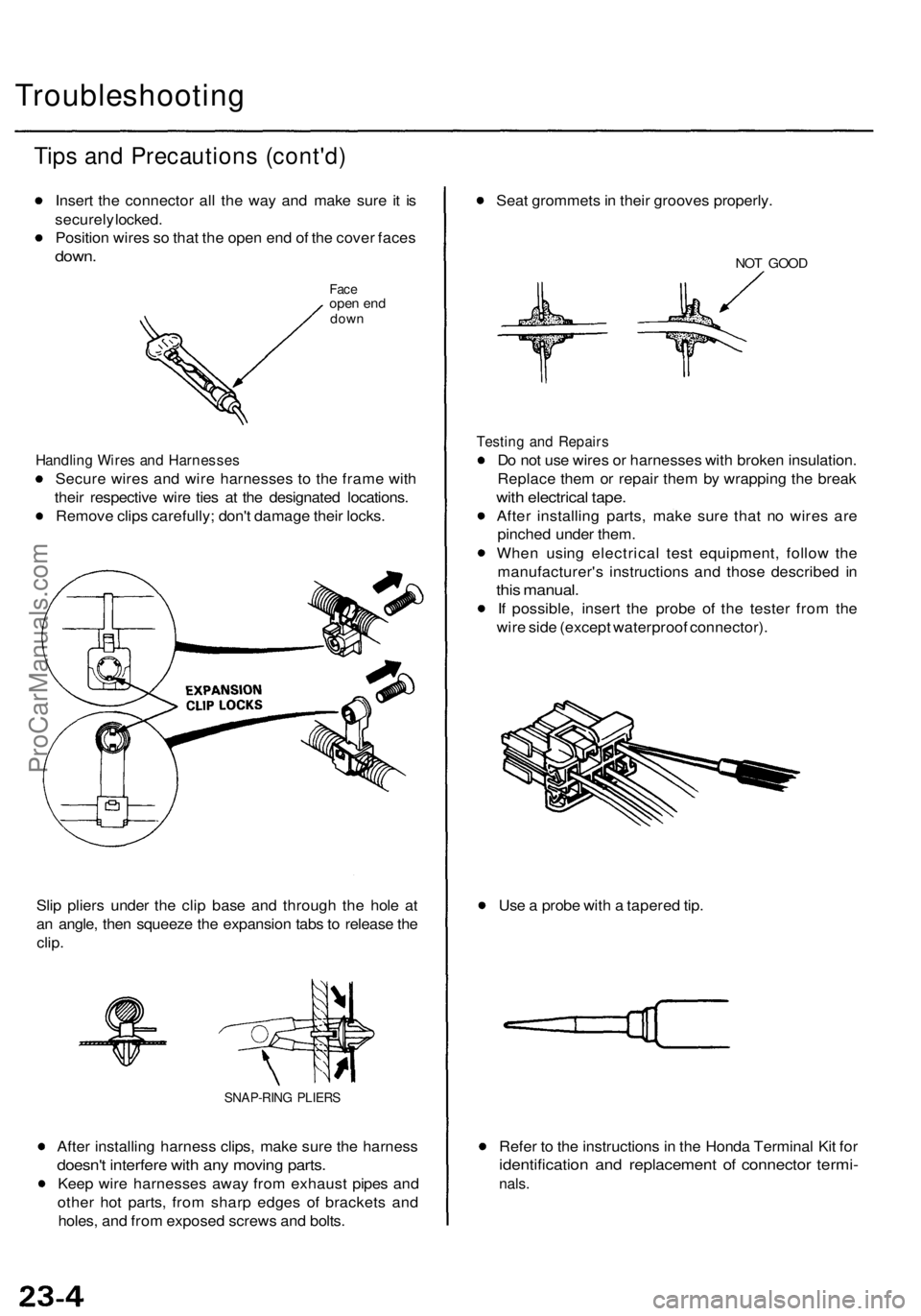
Troubleshooting
Tips and Precautions (cont'd)
Insert the connector all the way and make sure it is
securely locked.
Position wires so that the open end of the cover faces
down.
Face
open end
down
Handling Wires and Harnesses
Secure wires and wire harnesses to the frame with
their respective wire ties at the designated locations.
Remove clips carefully; don't damage their locks.
Slip pliers under the clip base and through the hole at
an angle, then squeeze the expansion tabs to release the
clip.
SNAP-RING PLIERS
After installing harness clips, make sure the harness
doesn't interfere with any moving parts.
Keep wire harnesses away from exhaust pipes and
other hot parts, from sharp edges of brackets and
holes, and from exposed screws and bolts.
Seat grommets in their grooves properly.
NOT GOOD
Testing and Repairs
Do not use wires or harnesses with broken insulation.
Replace them or repair them by wrapping the break
with electrical tape.
After installing parts, make sure that no wires are
pinched under them.
When using electrical test equipment, follow the
manufacturer's instructions and those described in
this manual.
If possible, insert the probe of the tester from the
wire side (except waterproof connector).
Use a probe with a tapered tip.
Refer to the instructions in the Honda Terminal Kit for
identification and replacement of connector termi-
nals.ProCarManuals.com
Page 1538 of 1771
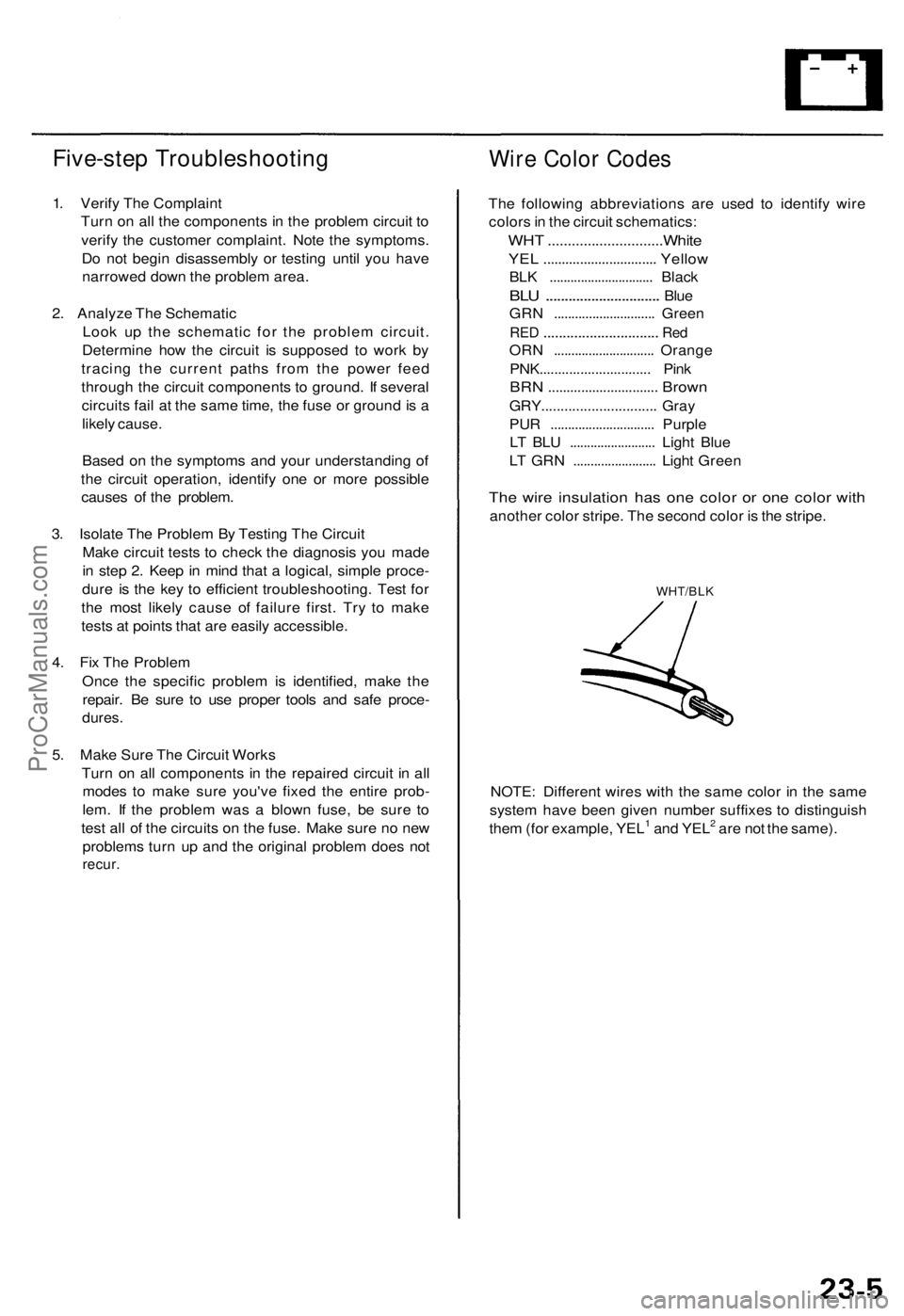
Five-step Troubleshooting
1. Verify The Complaint
Turn on all the components in the problem circuit to
verify the customer complaint. Note the symptoms.
Do not begin disassembly or testing until you have
narrowed down the problem area.
2. Analyze The Schematic
Look up the schematic for the problem circuit.
Determine how the circuit is supposed to work by
tracing the current paths from the power feed
through the circuit components to ground. If several
circuits fail at the same time, the fuse or ground is a
likely cause.
Based on the symptoms and your understanding of
the circuit operation, identify one or more possible
causes of the problem.
3. Isolate The Problem By Testing The Circuit
Make circuit tests to check the diagnosis you made
in step 2. Keep in mind that a logical, simple proce-
dure is the key to efficient troubleshooting. Test for
the most likely cause of failure first. Try to make
tests at points that are easily accessible.
4. Fix The Problem
Once the specific problem is identified, make the
repair. Be sure to use proper tools and safe proce-
dures.
5. Make Sure The Circuit Works
Turn on all components in the repaired circuit in all
modes to make sure you've fixed the entire prob-
lem. If the problem was a blown fuse, be sure to
test all of the circuits on the fuse. Make sure no new
problems turn up and the original problem does not
recur.
Wire Color Codes
The following abbreviations are used to identify wire
colors in the circuit schematics:
WHT .............................White
YEL ............................... Yellow
BLK .............................. Black
BLU
..............................
Blue
GRN ............................. Green
RED
..............................
Red
ORN ............................. Orange
PNK.............................. Pink
BRN .............................. Brown
GRY.............................. Gray
PUR .............................. Purple
LT BLU ......................... Light Blue
LT GRN ........................ Light Green
The wire insulation has one color or one color with
another color stripe. The second color is the stripe.
WHT/BLK
NOTE: Different wires with the same color in the same
system have been given number suffixes to distinguish
them (for example, YEL1 and YEL2 are not the same).ProCarManuals.com
Page 1539 of 1771
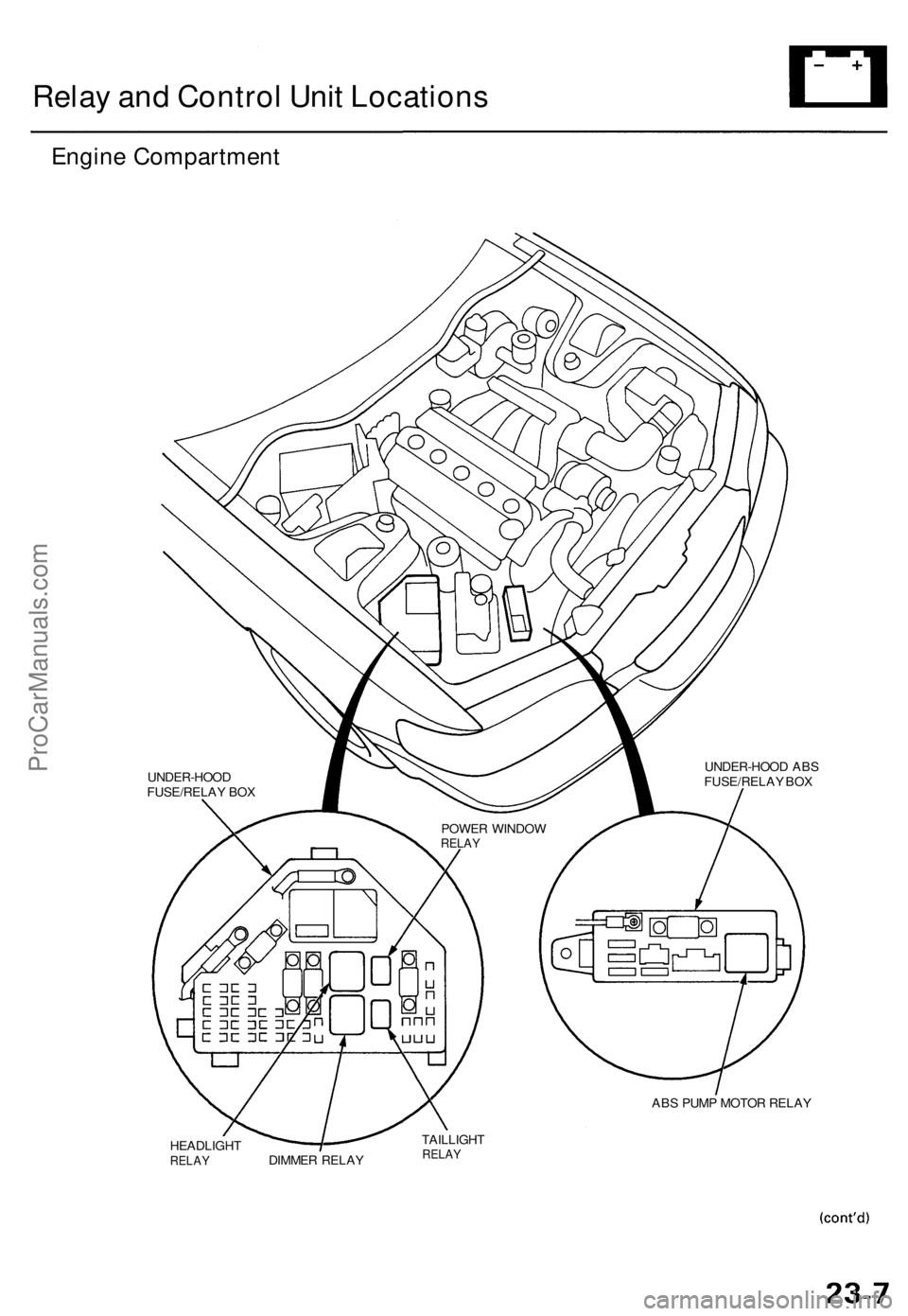
Relay and Control Unit Locations
Engine Compartment
UNDER-HOOD ABS
FUSE/RELAY BOX
ABS PUMP MOTOR RELAY
HEADLIGHT
RELAY
DIMMER RELAY
TAILLIGHT
RELAY
POWER WINDOW
RELAY
UNDER-HOOD
FUSE/RELAY BOXProCarManuals.com
Page 1540 of 1771
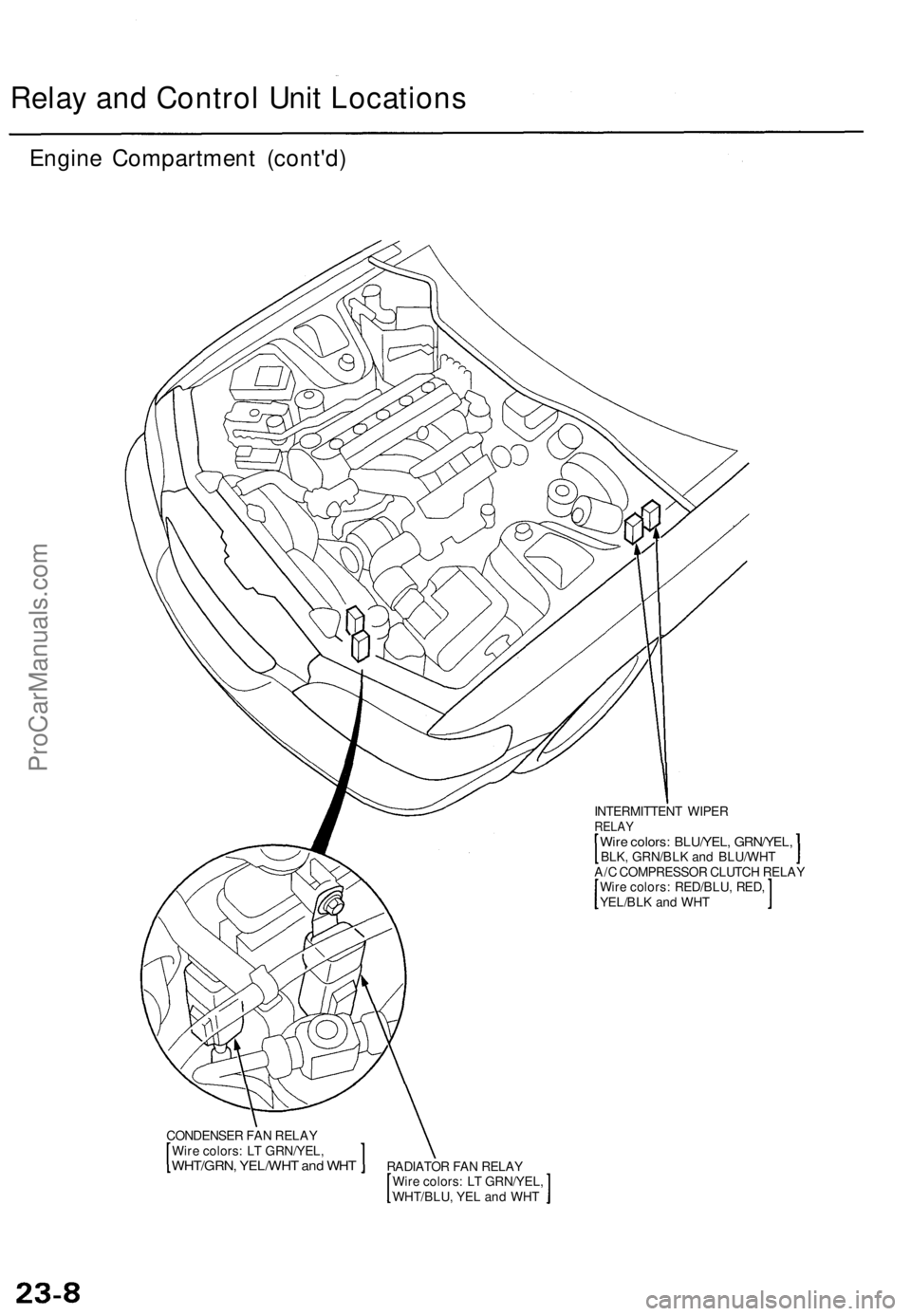
Relay and Control Unit Locations
Engine Compartment (cont'd)
INTERMITTENT WIPER
RELAY
Wire colors: BLU/YEL, GRN/YEL,
BLK, GRN/BLK and BLU/WHT
A/C COMPRESSOR CLUTCH RELAY
Wire colors: RED/BLU, RED,
YEL/BLK and WHT
CONDENSER FAN RELAY
Wire colors: LT GRN/YEL,
WHT/GRN, YEL/WHT and WHT
RADIATOR FAN RELAY
Wire colors: LT GRN/YEL,
WHT/BLU, YEL and WHTProCarManuals.com